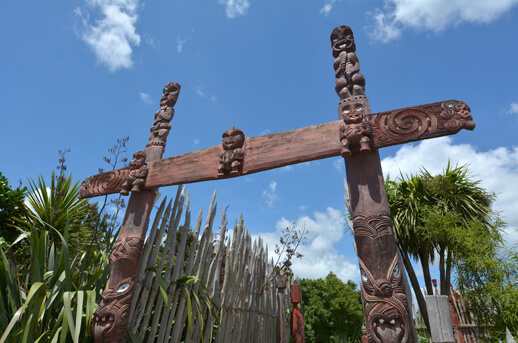Her work and pieces by about 40 other Maori artists are included in an exhibition, "Toi Maori: The Eternal Thread," due to visit San Francisco, Salem Ore., Warm Springs, Ore., and Seattle from August 2005 through June 2006. The display is considered the most significant exhibit of Maori weaving ever to leave the country. It represents the work of current artists, expressed in traditional, contemporary and abstract forms. Elders will accompany the collection.

The touring exhibition is supported by the New Zealand government and the Maori queen, Dame Te Atairangikaahu, as well as Toi Maori Aotearoa, a Maori arts organization.
"The pathway this exhibition travels will be a rich journey which will see our Maori people interact and exchange knowledge, skills and friendships with the peoples of the United States of America and Canada," said Waana Davis, chairwoman of Toi Maori Aotearoa. "In turn, we hope it encourages people from those countries to come and visit us so that we can learn more about each other, develop everlasting friendships, and build a strong future for the generations to follow."
<<
The exhibit will feature rare and precious cloaks from the collections of the Hetet family, the Te Kanawa family and other weaving dynasties. The cloaks are not only exquisite works of art, but are seen as coats of leadership and spiritual protection, reflecting the status of tribal leaders among their people. Maori believe that a cloak becomes empowered by the status and spiritual power, or mana, of the owner and as a result the mana of the cloak increases when worn. Included in the exhibition are large photos of Maori ancestors wearing cloaks, providing evidence of the significance of the cloak within the culture.
Also included in the display are "piupiu" (flax skirts) and "kete" (baskets) made from plant fibers.
Weaving, once used to clothe, furnish or decorate, is now sometimes used by a new generation of artists for broader, interpretive meaning. The exhibit's abstract works in metal, shells and fabric are based on traditional forms and techniques.
<<
"There's a quota now, of 10 paua per day per family," said Puketapu-Hetet. She said the New Zealand government has imposed a limit, whereas once the shellfish were a staple Maori diet.
Hetet said Maori who learn to weave are taught to be sensitive to nature and themselves.
"The difference between Maori weavers and other cultures is our approach," she said. "One of the first things taught is the smell." Part of the pleasure of owning a kete is its fragrance. "Also, touch and taste," she said.
The Maori learn not to gather after high winds, heat waves or rain, because the grasses are not at their best. They are also taught to wait until they, too, are in prime condition; for example, women don't collect materials during menstruation. Most of the weavers are women.
"If you want to do the best you can," said Puketapu-Hetet, "you must be in optimum condition."
<<
Young people in New Zealand can choose to learn weaving at a university or polytechnic, or they can learn the traditional way - from the elders.
Puketapu-Hetet believes that while formal tertiary education offers credibility and can help weavers find employment, sometimes mainstream learning glosses over or reinvents the art.
She likes to teach the way she was taught - starting with a cloak and working backward to learn about gathering the materials.
Hetet Studios, an educational facility she owns with her husband, master carver Rangi Hetet, has established a relationship with a polytechnic so the couple's students in the Maori arts can get certified. The studios are next to the Hetets' home at Waiwhetu.
Between teaching sessions, Puketapu-Hetet crafts her own designs. She began working with paua shells in the 1980s.
"I began thinking about my legacy and realized that fiber work will eventually disintegrate," she said.
She started making abstract metal kites so that the Maori kites would be remembered.
Puketapu-Hetet is expected to attend at least one of the openings of the touring "Toi Maori: The Eternal Thread." Some of her kites are included in exhibit.
IF YOU GO
"Toi Maori: The Eternal Thread"
An exhibition of traditional and contemporary Maori weaving from New Zealand
- Aug. 5-14
Yerba Buena Center for the Arts Forum
701 Mission Street (at Third)
San Francisco
- Sept. 24 - Dec. 23
Hallie Ford Museum of Art, Willamette University
700 State Street
Salem, Ore.
- Opens Feb. 4, 2006
Burke Museum of Natural History and Culture
University of Washington
17th Avenue NE and NE 45th Street
Seattle.
www.washington.edu/burkemuseum
- Opens June 4, 2006
The Museum at Warm Springs
Warm Springs, Oregon
Julie Pendray is a staff writer for The San Diego Union-Tribune.
© Copley News Service



